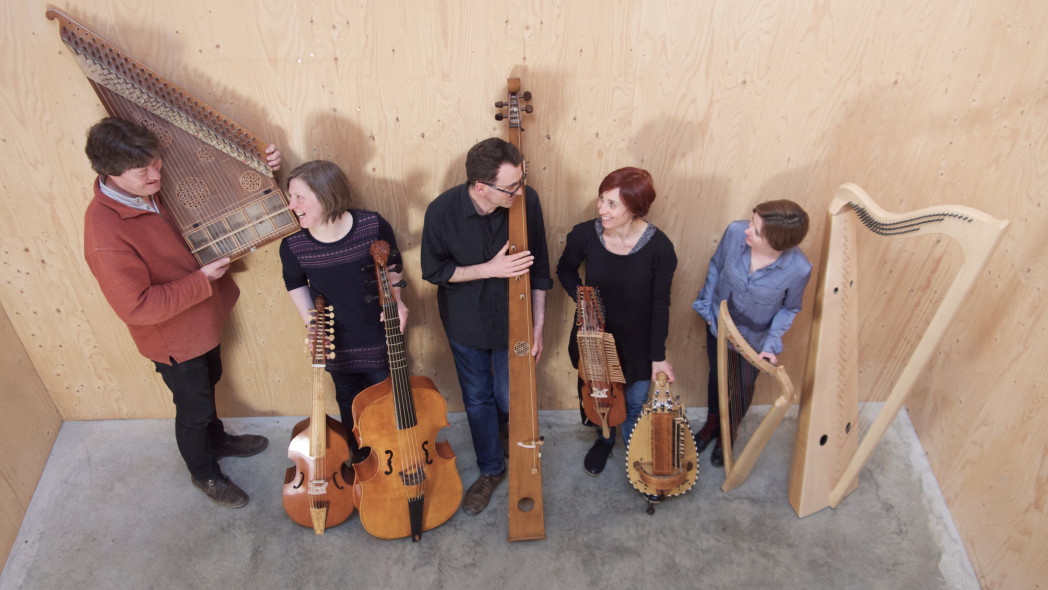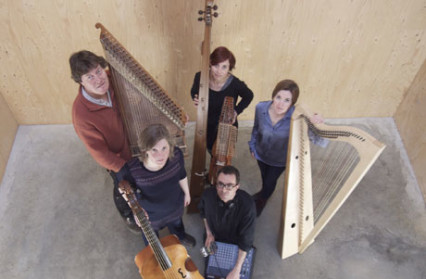Cath Barton reviews a performance of Sound House by the Society of Strange and Ancient Instruments, recreating some of Francis Bacon’s 17th century experiments with sound.
Clare Salaman is a musician who has always explored and experimented with different sound worlds, collaborating with composers and players from different countries and musical traditions in doing so. It is therefore fitting that for the exploration which has led to the performance called Sound House she took as her starting point the work of arch-innovator Francis Bacon. Bacon was the first in the modern world to study the natural world by observation and experiment rather than, as had prevailed before him, deduction. His posthumous work Sylva Sylvarum: a natural history in ten centuries covers 1,000 experiments in ten groups or centuries, two of which are devoted to sound.
In the modern world we are often overwhelmed by sounds which pile on top of and sometimes muddy one another, confusing our ears. Rarely if ever do we experience silence. Bacon appreciated, as John Cage’s experiments showed centuries later, that sound and the potential for music is all around us. It is instructive to take a Cageian walk from time to time, paying attention to the specific sounds we encounter, natural or man-made. What Clare Salaman and her musical collaborators in her Society of Strange and Ancient Instruments have done in Sound House is to recreate some of Bacon’s 17th century experiments with sound. As Alison McGillivray told us in her introduction to this concert, they took Bacon’s book Sylva Sylvarum to Snape Maltings, together with a variety of musical instruments, microphones, cardboard – which they wrapped into cones and used as ear trumpets – and a selection of piping. During a week’s residency they used these different components to explore, for example, “how sound is pent and travels through trunks” and, through that, to rekindle for themselves the sense of wonder which Bacon evidently felt about the nature of sound.

Sound House is a container for the product of this experimentation, designed to pass on the knowledge gained and indeed the rekindling of a sense of wonder about musical sounds to our jaded ears. The instrumental line-up here from the wide range used by the Society of Strange and Ancient Instruments was, essentially, viols and harps, instruments with which Francis Bacon would have been familiar, including the lyra viol, which has sympathetic strings, the lirone, the strings of which must be played in chords and the bray harp, with bray pins which lightly touch the strings and make them buzz. One which Bacon would not have known was the santouri, an ancient dulcimer from the Greek islands. It was a curious addition, but stood in interesting counterpoint to the others.
The group played 17th century repertoire from Tobias Hume, William Lawes, Robert Jones, William Brade, Byrd, Tomkins and Gibbons, together with contemporary compositions from composer/sound designer Jon Nicholls and work developed by the group from improvisations. The sounds made by the players in the hall were enhanced by the use of electronics, including recordings made on location. This was never less than compelling and enthralling, although I had mixed feelings about hearing extracts from Bacon’s writings read (in a prior recording made by the actor Terence Wilton), especially when the clarity of the musical sounds was obscured by the voice-over. Contrary-wise, when the players spoke some of the words softly, in their piece A Sweet Voice of One That Readeth, I experienced that as an integral part of the sound world being explored. It was fittingly included too, for as Clare Salaman says of the voice, it is ‘The most strange and ancient instrument of all’, here providing a susurration, perhaps inspired by the sound of the sea near Snape Maltings.
The instruments played in Sound House do not have a huge dynamic range, so that as a listener to this music you are never bombarded, but rather must pay attention and be drawn in, lulled as it were. It is intriguing to consider Bacon’s observation that “between sleeping and waking (when all the Senses are bound and suspended) Musick is far sweeter than when one is waking.” As I listened I recalled Caliban’s lines from The Tempest:
Be not afeard; the isle is full of noises,
Sounds, and sweet airs, that give delight and hurt not.
Sometimes a thousand twangling instruments
Will hum about mine ears, and sometimes voices
That, if I then had waked after long sleep,
Will make me sleep again.
Some would have it that Francis Bacon wrote Shakespeare’s plays. Never mind that, but they were contemporaries and Shakespeare too would have been familiar with the sounds of these instruments.
Not that this is all about the sweetness of sound. Another of the areas in which Bacon experimented is that of ‘Concords and Discords of Musick’, as between different sorts of instruments. Jon Nicholls’ piece of that title exploring the subject in, as he puts it, ‘a succession of mini speed-dates between different instrument combinations’ is an amusing vignette with a concluding flourish from the slightly dissonant santouri. Indeed Sound House as a whole is a collection of vignettes, a sampler as it were of some of the ways in which sound can be explored. As such it is rich source material for further investigation by any of us as we play, sing and listen to music from whatever period.
The title Sound House is taken from an unfinished utopian novel by Bacon, New Atlantis, in which he may have been foreseeing the development of electronic manipulation of sound. Such manipulations as were part of the performance I heard, such as echo effects, were subtle. Alison McGillivray had brought a length of 6 inch down pipe on stage and talked about how the group had experimented with it using microphones. I rather wished they had given us a taster of that live in performance. I’m sure they had huge fun at Snape Maltings, but it felt as if they had rather toned it down for the concert hall. I wanted to hear a side of viol and harp music that isn’t so polite, a little danger and even roughness as well as the carefully modulated sounds, which is something that electronics makes possible. I would have liked to have heard the sound of Caliban’s thousand twangling instruments.
This performance introduced me to new ideas and fresh perspectives, from experiments with the direction of sound to the action of air and the concluding remark from Francis Bacon that “[Men] should accustom themselves… to enlarge their mindes to the amplitude of the World; and not to reduce the World to the narrowness of their Mindes.” The notion that “extreme applauses” might break the air so that birds fall out of the sky is a particularly potent one. The excellent players of the Society of Strange and Ancient Instruments certainly deserved the fulsome applause that they received from an audience which included a gratifyingly large number of young people.
The Society of Strange and Ancient Instruments
Dora Stoutzker Hall, Royal Welsh College of Music and Drama, Cardiff, 2 March 2016
The Society of Strange and Ancient Instruments: Sound House
Devised and directed by Clare Salaman
Jon Banks: santouri, gothic harp, percussion
Liam Byrne: lirone, treble viol
Jean Kelly: triple harp, bray harp
Alison McGillivray: bass viol, lyra viol
Jo Will: electronics
Extracts from Sylva Sylvarum by Francis Bacon (1561-1626) read by Terence Wilton
Cath Barton won the New Welsh Writing AmeriCymru Prize for the Novella with The Plankton Collector, which is published by New Welsh Review under their Rarebyte imprint. Her second novella, In the Sweep of the Bay, will be published by Louise Walters Books in September 2020, and in early 2021 Retreat West Books will publish her collection of short stories inspired by the work of the Flemish artist Hieronymus Bosch.



 Enjoyed this article? Support our writers directly by buying them a coffee and clicking this link.
Enjoyed this article? Support our writers directly by buying them a coffee and clicking this link.







